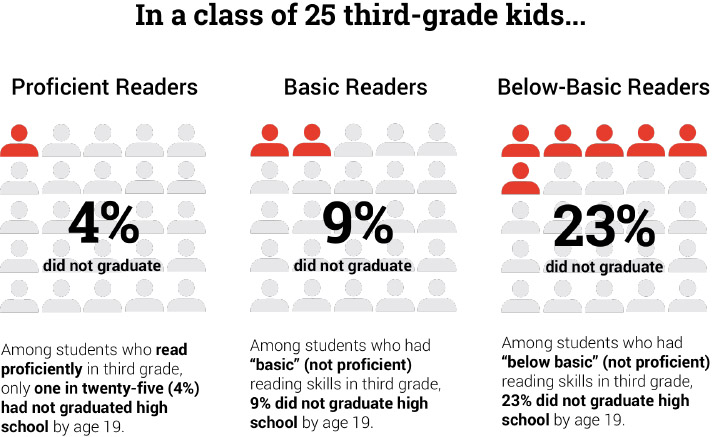Reading Strategies for Struggling Readers
By Kiran Gokal
There are many reasons why a student might have a hard time reading, whether related to a learning disability or simply a lack of interest. The key to improving with either is to build confidence and provide skills and tools for the student to use. A phonics program can help students struggling to read by teaching them several different skills to set them up for success. Read on to get a glimpse of what these methods are.


First, what is a struggling reader?
A struggling reader means that a young child has difficulty in reading. Struggling readers have a difficult time due to factors outside their control. But with the proper teaching techniques and strategies, they will typically make significant improvements.
And while many factors can lead to reading struggles, there are strategies that can encourage them to excel.
How to Help a Struggling Reader?
Reading can be a difficult task for children for many different reasons. It can be hard to perform well in the classroom, especially if the students feel that there is pressure.
Add a learning disability like ADHD or dyslexia to that pressure, and struggling readers will have difficulty performing well. And sometimes, students are simply uninterested, depending on where their interests lie.
Top Strategies for Struggling Readers
Target Vocabulary and Sight Words
Teaching children new vocabulary and sight words makes a significant impact in helping struggling readers and building their phonics knowledge. Your child will be able to pick up a book and read most of the text, which will increase your child’s confidence and motivate them to read even more.
This also helps support reading comprehension and is critical to providing clues for the context of the text. They can focus on decoding anything unfamiliar using the book’s story, plot, illustrations, and context.
Use Shared Reading
Shared reading is another excellent way to boost the confidence of young struggling readers that are having a hard time finding success when they read.
What is Shared Reading?
Shared reading is a type of instruction done in the classroom where the student joins a teacher in an interactive reading experience. During a shared or guided session, the teacher models all the skills of an experienced reader, including showing how they read fluently and with expression.
Then when the student is ready to join in, they gain confidence. Struggling readers learn by emulating the teacher and receiving close guidance from the instructor.
How is it Helpful?
Shared reading is a tool that many instructors use when helping struggling readers. Not only does an instructor-guided session make struggling readers feel more comfortable, it takes the pressure off them to have to read an entire book on their own.
Many times the student will alternate with the teacher. The instructor focuses on teaching different skills while kids listen and emulate.
This strategy is highly effective because struggling readers will get one-on-one attention and guidance to fix any fluency issues or help decode a tricky word. It also allows kids to watch how the teacher is confident when they read.

Identify Tricky Words
Before your son or daughter opens up a book, before even beginning at the very first page, you want them to take a moment to skim through the pages and find a few tricky words that they struggle to recognize and find meaning.
This is another excellent method to support struggling readers and kids with dyslexia, who may be discouraged when they come across a tricky word when they read.
After struggling readers identify a problematic word in the book, they must work with the teacher or parent to write it out on a whiteboard or paper to decode it phonetically to read it.
Why Is This Important?
This process is significant for helping struggling readers because it supports word recognition and helps them decode by interactively writing it and visualizing it. Once they learn new words and recognize them in the book they’re working through, they are one step closer to being fluent.
Oral Reading
Oral reading is challenging when helping struggling readers because it puts all the mistakes on display. However, at the same time, this method is very effective in getting kids to be aware of their reading methods when they can present them out loud to teachers and themselves.
This method can teach skills such as confidence, using expression and emotion, and minimize mistakes such as skipping over a word or substituting a word. And if they struggle, the teacher is there to teach them how to correct themselves. Use this method in a private setting where you know the child is comfortable and more confident.
This method also promotes comprehension by allowing them to take in the story they are presenting audibly and then recall details more clearly and infer meaning from the story.
Use the Tracking Method
Lastly, the tracking method is crucial for helping struggling readers not make mistakes and focus while reading. For children with learning disabilities such as dyslexia, have them use something to track their reading on the page. This can be very advantageous for the new reader.
Using their finger or another tool to draw their eyes to the letters on the page allows readers to minimize the mistakes they make–meaning no substituting, less guessing, and more decoding.
It also helps a student read with expression and take pauses after punctuation. Reading orally without something to focus the child’s attention on the page leads to unnecessary mistakes that can deter your child from reaching new reading levels.
Practice Reading Methods for Success
These methods are essential to equip your child with the skills they need to read successfully. With consistent practice, teaching, and the proper instruction, your child should show improvement.
These skills boost confidence in your child, but they can also support their interest in reading. When children feel confident while they read, they’re more likely to pick up books and be interested and engaged. These methods are proven to assist struggling readers to do the best to their ability and set them up for even more difficult challenges.
The Reading Ranch Method
Struggling readers can experience a variety of difficulties, including dyslexia or ADHD. The Reading Ranch Intervention Program is a research-based program for struggling readers that has been shown to quickly reduce the reading gap by up to 50%. If you’re looking for help with your child who struggles in school and at home because they can’t read well enough to keep up with their peers, contact us today. We offer either online or in-person programs we feel confident we have something just right for every family.

